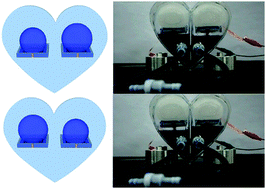A large-deformation phase transition electrothermal actuator based on carbon nanotube–elastomer composites†
Abstract
An electrothermal phase transition actuator based on a superaligned carbon nanotube film and elastomers has been designed and fabricated. Compared with a conventional electrothermal bimorph actuator using cantilever structures, this new-type actuator introduces a novel concept of phase transition large-deformation actuation. The actuator consists of an enclosed cavity made up of highly elastic elastomers and an embedded carbon nanotube based electrical heater. A low-boiling liquid was injected into the cavity and it can vaporize rapidly to make the elastic cavity expand significantly when electrically heated. The size and speed of the expansion can be easily controlled by the applied voltage (electrical power). The expanded elastomer membrane can lift more than 1000 times of its own weight. The cyclic actuation test shows the excellent durability of the actuator. A heart-shaped closed liquid circulation system based on the phase transition pump-type actuators has been made, which can work like a real heart. Owing to the advantages of low driving voltage, large deformation, simple fabrication, easy operation, lightweight and durability, we think that the phase transition actuator will have great potential usage in various areas, such as artificial muscles, soft robots, sensors, and especially in the biomedical field.


 Please wait while we load your content...
Please wait while we load your content...